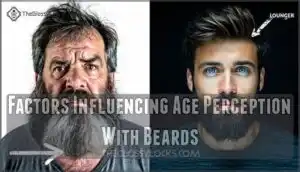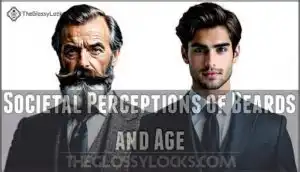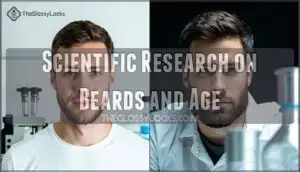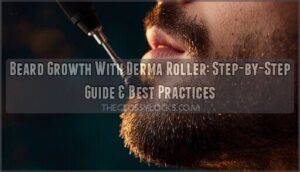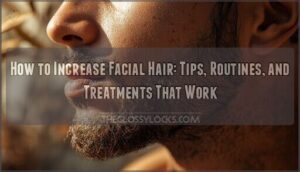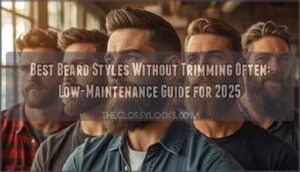This site is supported by our readers. We may earn a commission, at no cost to you, if you purchase through links.
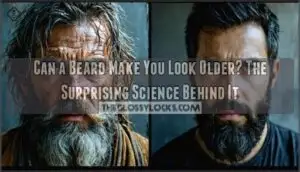
Gray or patchy facial hair tends to add years, while a well-groomed beard often projects maturity and sophistication.
The trick lies in the details—scraggly, unkempt beards can age you substantially, but a neatly trimmed style might actually enhance your features.
Color contrast plays a huge role too; if your beard’s much darker or lighter than your hair, it creates visual inconsistency that confuses age perception.
Think of your beard as a frame for your face—the right frame makes the picture shine, while the wrong one throws everything off balance.
Table Of Contents
- Key Takeaways
- Can a Beard Make You Look Older?
- Factors Influencing Age Perception With Beards
- Influence of Beard Growth Patterns on Age Perception
- Societal Perceptions of Beards and Age
- Impact of Beards on Attractiveness and Age Perception
- Scientific Research on Beards and Age
- Frequently Asked Questions (FAQs)
- Do beards make you look older?
- How old were you when your beard started growing?
- Can a trimmed beard make you look younger?
- How old do men look if they have a beard?
- Does removing beard make you look younger?
- What is the 3 month beard rule?
- Does having a beard reduce aging?
- Do I look better with or without a beard?
- What age does a beard look good?
- Can a beard change the way you look?
- Conclusion
Key Takeaways
- Your beard typically adds about 8 years to your perceived age – research consistently shows that facial hair makes people guess you’re nearly a decade older than you actually are, with longer and fuller beards creating the strongest aging effect.
- Gray whiskers instantly age you, while well-groomed styles can enhance your attractiveness – patchy or salt-and-pepper beards add more years to your appearance, but a neatly trimmed beard projects sophistication and maturity without looking unkempt.
- Your beard’s length and maintenance determine whether it helps or hurts your image – short, well-maintained facial hair keeps you looking younger, while longer, poorly groomed beards can make you appear careless and significantly older than intended.
- Society automatically associates beards with wisdom and experience – cultural perceptions link facial hair to maturity and authority, meaning your beard becomes an instant visual cue that triggers assumptions about your age and life experience.
Can a Beard Make You Look Older?
Absolutely, your beard can make you look older – and science backs this up.
Research shows that beards add an average of eight years to your perceived age, creating a powerful beard age correlation that’s hard to ignore.
Beards don’t just grow on your face—they grow years on your appearance, adding nearly a decade to how old others think you are.
The beard aging illusion works through several mechanisms.
Gray beards instantly signal maturity, while longer, fuller beards suggest wisdom and experience.
This facial hair maturity effect isn’t just in your head – it’s rooted in how our brains process visual cues about age.
However, beard perception factors matter tremendously.
A neat, well-defined beard speaks sophistication, while patchy growth can actually make you appear younger.
The key lies in understanding how beard and perceived age interact with your natural features.
Whether you’re aiming for distinguished maturity or youthful energy, knowing how your whiskers affect others’ perceptions gives you control over your image.
Your beard isn’t just hair – it’s a powerful tool for shaping first impressions.
Factors Influencing Age Perception With Beards
Your beard’s appearance doesn’t age you by accident—specific factors like color, style, and length work together to influence how old others think you are.
Think of your facial hair as a visual cue that sends signals about maturity, with gray whiskers adding years while a well-trimmed style can keep you looking younger than your clean-shaven friends.
Beard Color
In the context of beard color, you’re dealing with a game-changer for age perception.
Gray hair in your beard can instantly add years to your appearance, while natural shades keep you looking younger.
The graying process affects beard pigmentation faster than scalp hair, creating that distinguished salt and pepper look.
Here’s what impacts your beard appearance:
- Gray beards often make men look far older than their actual age
- Color uniformity with natural hair creates a youthful image
- Patchy pigmentation may actually make you appear younger
- Dyeing beards can enhance overall attractiveness and perceived age, making it a significant factor in how old you look.
Beard Style
The right beard style can make or break your age game.
A neat, clean, defined beard signals maturity and sophistication, while unkempt or patchy growth screams inexperience.
Your face shape determines which styling techniques work best—round faces need angular cuts, square faces benefit from softer edges.
Smart maintenance routines and following current beard trends help you control whether your beard makes you look older or younger.
Notably, societal perceptions often link facial hair to adulthood and maturity.
| Style Type | Age Effect | Best For |
|---|---|---|
| Full Beard | Adds 5-8 years | Square, oval faces |
| Goatee | Neutral aging | Round, heart shapes |
| Stubble | Youthful look | All face types |
| Chinstrap | Minimal aging | Defined jawlines |
| Soul Patch | Trendy, younger | Experimental looks |
Beard Length
Beyond style choices, beard length plays a major role in how old you appear.
Longer beards consistently add years to your look, while shorter ones keep you appearing younger. Length and Maturity go hand-in-hand—people associate extended growth with wisdom and experience.
However, Trimming Effects can work in your favor. Short Beard Youthfulness counters aging, especially when well-maintained.
Long Beard Sophistication appeals to those wanting gravitas, but requires careful Length and Maintenance. Your facial hair aging effect depends entirely on finding that sweet spot.
Consider exploring a detailed beard guide for ideal results.
Influence of Beard Growth Patterns on Age Perception
Beyond the simple presence of a beard, your growth pattern aging effect determines how old you actually appear.
Think of your facial hair as nature’s age filter—patchy beard youth signals still developing, while full beard maturity broadcasts experience.
Here’s how different beard growth patterns influence your perceived age:
- Patchy or Uneven Growth: Creates a youthful appearance since it suggests you’re still in the developmental phase of facial hair maturity
- Dense, Full Coverage: Projects authority and wisdom, making you look substantially older than clean-shaven counterparts
- Strategic Density Variations: Light stubble often appears most attractive while maintaining a younger look compared to fuller beards
Your beard makes older impressions through density and perception cues.
Uneven growth age effects can actually work in your favor if you’re aiming for a more youthful appearance, while facial hair aging happens faster with fuller coverage.
Studies suggest that beards can add to your overall perceived age.
Societal Perceptions of Beards and Age
Society has long linked beards and wisdom, creating powerful cultural age markers that shape how we perceive facial hair.
Your beard doesn’t just change your appearance—it triggers deep-seated beard stereotypes rooted in centuries of tradition.
Media portrayal consistently shows bearded men as experienced leaders, from ancient philosophers to modern CEOs.
These societal perceptions mean your facial hair becomes an instant visual age amplifier. While evolving perceptions are slowly shifting these beard age stereotypes, the connection between beards and maturity remains strong.
Understanding this beard age perception helps explain why your whiskers might add years to your appearance overnight.
Impact of Beards on Attractiveness and Age Perception
How does your beard affect both your attractiveness and how old you appear? The connection between beard attractiveness and age perception runs deeper than you’d think.
Research shows that your facial hair directly impacts relationship suitability depending on its style and maintenance. Clean-shaven men and those with full beards score highest for long-term relationships, while stubble attractiveness peaks for casual dating scenarios.
This creates an interesting dynamic where grooming influence plays a major role in how others perceive your beard visual age. A well-maintained beard can enhance your attractiveness while adding maturity, but there’s a sweet spot.
Ten-day stubble consistently ranks as most attractive to women, balancing youthful appeal with masculine maturity. However, poorly groomed facial hair can backfire, making you appear older without the sophisticated edge.
Your beard age perception ultimately depends on how you style and maintain it—neat grooming projects confidence while unkempt growth suggests carelessness.
Scientific Research on Beards and Age
Research-backed evidence shows you’re not imagining things when people guess you’re older with a beard. Scientific research confirms that facial hair can age your appearance by nearly eight years on average.
Study methodologies have consistently used photo comparisons, where participants view the same men with and without beards to measure age perception differences. Sample sizes in these studies typically range from 100 to 300 participants, ensuring statistical significance in results.
Data analysis reveals that beard visual age effects aren’t just cultural assumptions—they’re measurable phenomena. One landmark 2013 study found that longer, fuller beards create the strongest aging effect, making you wonder does beard age you more than you’d expect.
Longitudinal studies tracking the same individuals over time show that beard age appearance consistently adds years to perceived age across different demographics and cultures, validating earlier findings. In addition to perceived age, beards can also signal dominance and maturity, influencing social dynamics.
Frequently Asked Questions (FAQs)
Do beards make you look older?
Yes, you’ll look about 8 years older with a beard.
Studies show longer, fuller beards age you more than short ones.
Gray whiskers add even more years, while patchy growth can actually make you appear younger.
How old were you when your beard started growing?
Facial fuzz first flourishes for most guys between ages 13-16, though some lucky dudes see whiskers earlier at 12, while others wait until
Your genetics basically call the shots on when you’ll start sporting stubble.
Can a trimmed beard make you look younger?
A well-trimmed beard can shave years off your appearance compared to a wild, unkempt one. Clean lines and proper grooming create a youthful, sophisticated look that’s mature without being aged.
How old do men look if they have a beard?
While you might think age perception varies wildly, studies consistently show bearded men look about 8 years older than clean-shaven counterparts.
Your facial hair basically adds nearly a decade to how others guess your age, which can be a significant factor in age perception.
Does removing beard make you look younger?
Shaving off your beard can instantly take years off your appearance.
Studies show beards add about eight years to perceived age, so going clean-shaven typically makes you look younger and more youthful.
What is the 3 month beard rule?
Like Rome wasn’t built in a day, your beard needs time to flourish.
The 3-month rule means you’ll resist trimming for twelve weeks, letting patchy spots fill in and revealing your beard’s true potential.
Does having a beard reduce aging?
Having a beard doesn’t reduce aging—it actually makes you look older by about 8 years on average.
Your beard adds maturity and sophistication, but it won’t slow down Father Time’s march forward.
Do I look better with or without a beard?
Your beard preference depends on your goals and face shape.
Research shows beards add roughly eight years to perceived age, while clean-shaven looks appear younger.
Consider your lifestyle, maintenance commitment, and desired image when deciding.
What age does a beard look good?
Age is just a number, but your beard’s prime time hits around 25-
You’ve got thick growth, fewer patches, and the maturity to maintain it properly.
After 40, gray hairs might age you faster than intended, which can be considered the prime factor in aging appearance.
Can a beard change the way you look?
Your beard transforms your entire appearance beyond just adding years. It reshapes your jawline, changes facial proportions, and shifts how others perceive your personality – from approachable to mysterious overnight.
Conclusion
Ultimately, the answer to "can a beard make you look older" isn’t straightforward—it depends entirely on how you wear it.
Your grooming habits, color choices, and style decisions determine whether facial hair adds distinguished maturity or unwanted years.
The science shows that well-maintained beards often enhance attractiveness while poorly kept ones age you prematurely.
Remember, your beard reflects your attention to detail, so treat it like the powerful style statement it truly is, and consider how it impacts your overall appearance, making you look either older or more attractive.
- https://voltgrooming.com/do-beards-make-you-look-older/?srsltid=AfmBOoqfJSXYlVPgm6QYTaMavngxY-Y0FkyD7M1YVA_hE5MPZw_XsSy9
- https://www.beardbeasts.com/blogs/news/do-beards-make-you-look-older?srsltid=AfmBOop8qHgSv6v85X-sOub4kFRuypuibHuW6f8PJWT5CcFOccMzBl_q
- https://www.wild-willies.com/a/blog/do-beards-make-you-look-older-tips-for-a-younger-looking-beard
- https://www.quora.com/Does-having-a-full-beard-make-you-look-older-than-someone-with-a-clean-shave
- https://www.genesishcs.org/wellness/lifestyle/are-beards-good-your-health

